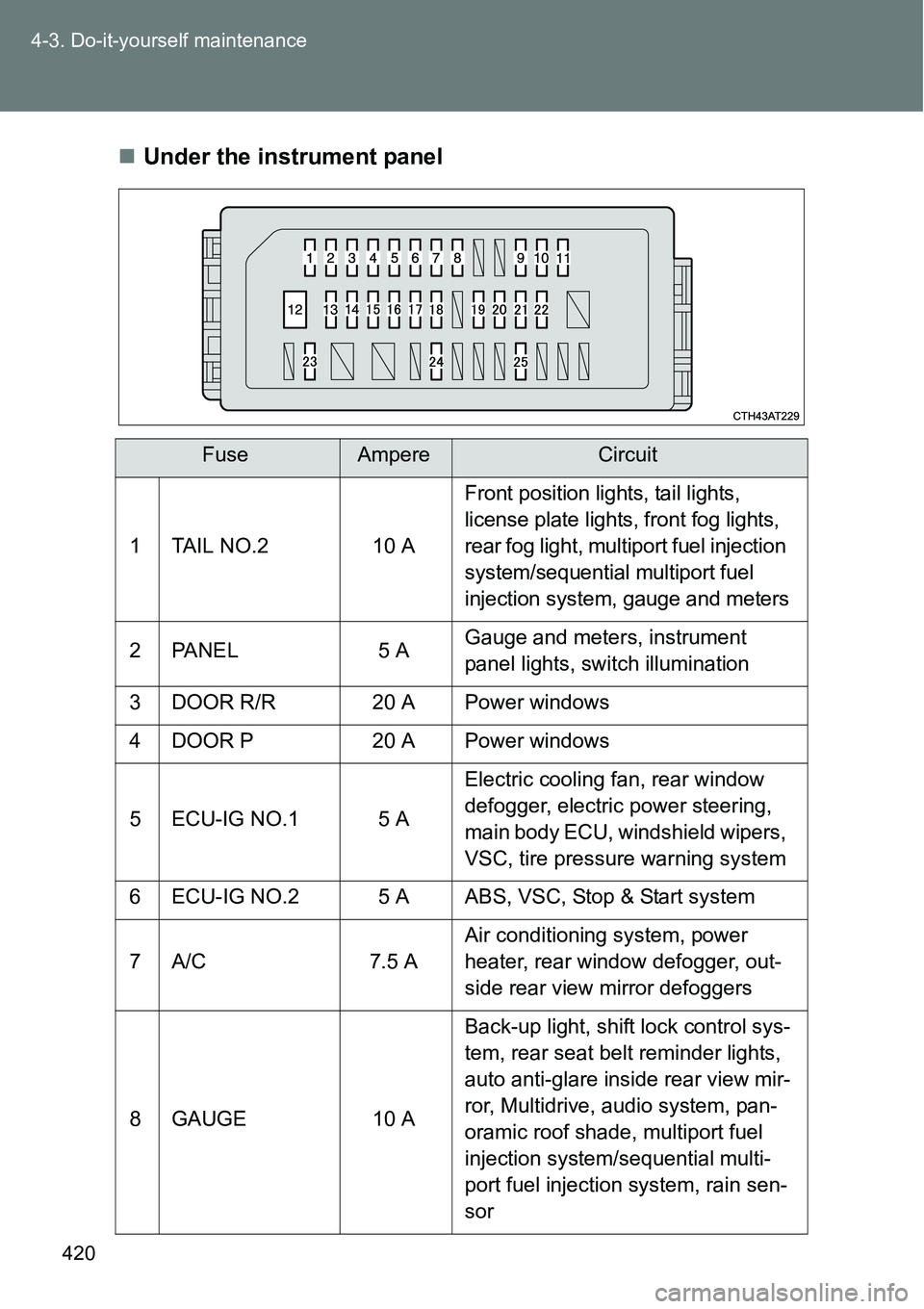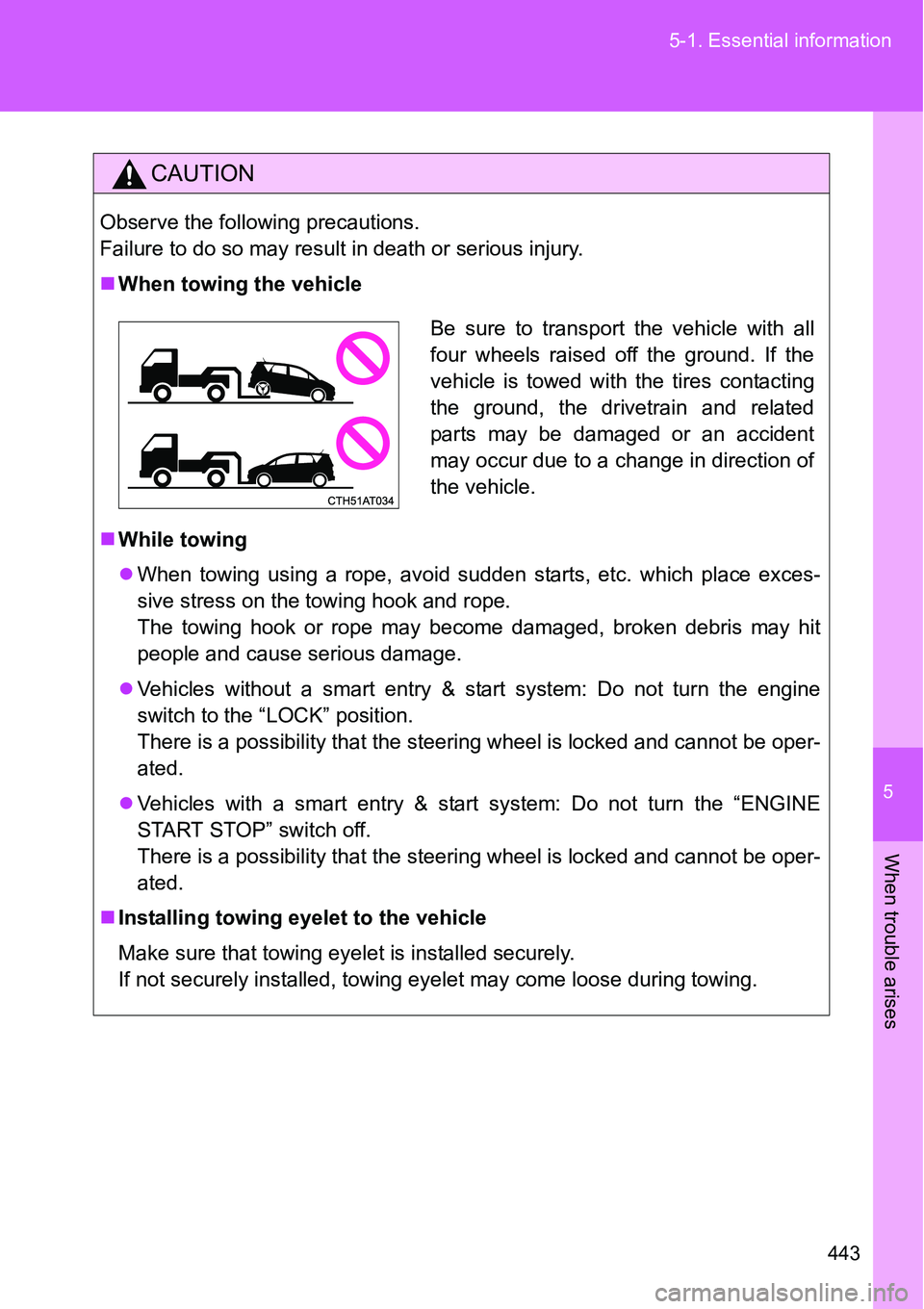Page 420 of 564

420 4-3. Do-it-yourself maintenance
Under the instrument panel
FuseAmpereCircuit
1 TAIL NO.2 10 A
Front position lights, tail lights,
license plate lights, front fog lights,
rear fog light, multiport fuel injection
system/sequential multiport fuel
injection system, gauge and meters
2 PANEL 5 AGauge and meters, instrument
panel lights, switch illumination
3 DOOR R/R 20 A Power windows
4 DOOR P 20 A Power windows
5 ECU-IG NO.1 5 AElectric cooling fan, rear window
defogger, electric power steering,
main body ECU, windshield wipers,
VSC, tire pressure warning system
6 ECU-IG NO.2 5 A ABS, VSC, Stop & Start system
7A/C 7.5 AAir conditioning system, power
heater, rear window defogger, out-
side rear view mirror defoggers
8 GAUGE 10 ABack-up light, shift lock control sys-
tem, rear seat belt reminder lights,
auto anti-glare inside rear view mir-
ror, Multidrive, audio system, pan-
oramic roof shade, multiport fuel
injection system/sequential multi-
port fuel injection system, rain sen-
sor
Page 421 of 564
421 4-3. Do-it-yourself maintenance
4
Maintenance and care
9 WASHER 15 A Windshield washer
10 WIPER 20 A Windshield wipers
11 WIPER RR 15 A Rear window wiper
12 P/W 30 A Power windows
13 DOOR R/L 20 A Power windows
14 DOOR 20 A Power windows
15 CIG 15 A Power outlets
16 ACC 5 AMain body ECU, outside rear view
mirrors, audio system, Stop & Start
system, shift lock control system
17 D/L 25 A Power door lock system
18 OBD 7.5 A On-board diagnosis system
19 FOG RR 7.5 A Rear fog light, gauge and meters
20 STOP 7.5 AMultiport fuel injection system/
sequential multiport fuel injection
system, smart entry & start system,
ABS, VSC, stop lights, high
mounted stoplight, shift lock control
system
21 AM1 7.5 A Starting system
22 FOG FR 15 A Front fog lights, gauge and meters
23 D-D/L 25 AMultiport fuel injection system/
sequential multiport fuel injection
system
24 SHADE 25 A Panoramic roof shade
25 S-HTR 15 A Seat heaters
FuseAmpereCircuit
Page 425 of 564
425 4-3. Do-it-yourself maintenance
4
Maintenance and care
Unplug the connector while
pressing the lock release.
Replace the light bulb, and install
the bulb base.
Align the 3 tabs on the light bulb
with the mounting and insert.
Turn and secure the bulb base.
Shake the bulb base gently to
check that it is not loose, turn the
headlights on once and visually
confirm that no light is leaking
through the mounting.
Install the cover.
STEP3
STEP4
STEP5
STEP1STEP6
Page 427 of 564
427 4-3. Do-it-yourself maintenance
4
Maintenance and care
Turn the bulb base counterclock-
wise.
Replace the light bulb, and install
the bulb base.
Align the 3 tabs on the light bulb
with the mounting and insert.
Turn clockwise and secure the
bulb base.
Install the connector.
Shake the connector gently to
check that it is not loose, turn the
front fog lights on once and visu-
ally confirm that no light is leaking
through the mounting.
When installing the fender liner, install by conducting
and with the directions reversed.
STEP4
STEP5
STEP6
STEP1STEP7STEP1STEP2
STEP1STEP1
Page 433 of 564
433 4-3. Do-it-yourself maintenance
4
Maintenance and care
CAUTION
Replacing light bulbs
Turn off the lights. Do not attempt to replace the bulb immediately after
turning off the lights.
The bulbs become very hot and may cause burns.
Do not touch the glass portion of the light bulb with bare hands. When it is
unavoidable to hold the glass portion, use and hold with a clean dry cloth
to avoid getting moisture and oils on the bulb.
Also, if the bulb is scratched or dropped, it may blow out or crack.
Fully install light bulbs and any parts used to secure them. Failure to do so
may result in heat damage, fire, or water entering the headlight unit. This
may damage the headlights or cause condensation to build up on the lens.
To prevent damage or fire
Make sure bulbs are fully seated and locked.
Page 440 of 564
440 5-1. Essential information
Emergency towing
If a tow truck is not available in
an emergency, your vehicle may
be temporarily towed using a
cable or chain secured to the
emergency towing eyelet. This
should only be attempted on
hard surfaced roads for 80 km
(50 miles) at low speeds.
A driver must be in the vehicle to
steer and operate the brakes.
The vehicle’s wheels, drive train,
axles, steering and brakes must
be in good condition.
For vehicles with a Multidrive,
only the front towing eyelet may
be used.
Page 441 of 564
5
441 5-1. Essential information
When trouble arises
Emergency towing procedure
Take out the towing eyelet. (P. 462, 475)
Press and hold the left side of
the eyelet cover while removing
the cover with a flathead screw-
driver.
To protect the bodywork, place a
rag between the screwdriver and
the vehicle body as shown in the
illustration.
Insert the towing eyelet into the
hole and tighten partially by
hand.
Tighten down the towing eyelet
securely using a wheel nut
wrench.
Securely attach a cable or chain to the towing eyelet.
Take care not to damage the vehicle body.
STEP1STEP6STEP1
STEP2
STEP3
STEP4
STEP1STEP6STEP1STEP5
Page 443 of 564

5
443 5-1. Essential information
When trouble arises
CAUTION
Observe the following precautions.
Failure to do so may result in death or serious injury.
When towing the vehicle
While towing
When towing using a rope, avoid sudden starts, etc. which place exces-
sive stress on the towing hook and rope.
The towing hook or rope may become damaged, broken debris may hit
people and cause serious damage.
Vehicles without a smart entry & start system: Do not turn the engine
switch to the “LOCK” position.
There is a possibility that the steering wheel is locked and cannot be oper-
ated.
Vehicles with a smart entry & start system: Do not turn the “ENGINE
START STOP” switch off.
There is a possibility that the steering wheel is locked and cannot be oper-
ated.
Installing towing eyelet to the vehicle
Make sure that towing eyelet is installed securely.
If not securely installed, towing eyelet may come loose during towing.
Be sure to transport the vehicle with all
four wheels raised off the ground. If the
vehicle is towed with the tires contacting
the ground, the drivetrain and related
parts may be damaged or an accident
may occur due to a change in direction of
the vehicle.